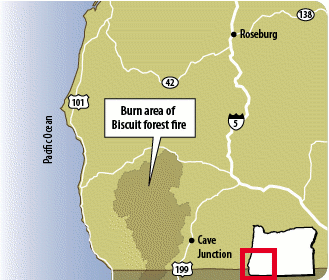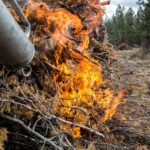It sounded like an unbelievable amount of money: more than $171 million worth of salvage lumber, enough to build as many as 17,000 homes, waiting to be logged in forests blackened by 2002’s famed Biscuit Fire.
 CAVE JUNCTION — It sounded like an unbelievable amount of money: more than $171 million worth of salvage lumber, enough to build as many as 17,000 homes, waiting to be logged in forests blackened by 2002’s famed Biscuit Fire.
CAVE JUNCTION — It sounded like an unbelievable amount of money: more than $171 million worth of salvage lumber, enough to build as many as 17,000 homes, waiting to be logged in forests blackened by 2002’s famed Biscuit Fire.
In the end, it proved to be an unbelievable estimation. Over the next four years, as delays grew and wood deteriorated, and the USDA Forest Service reduced the amount of acres that would be logged, the number sank lower and lower. By early 2006, after most of the salvage work had been done, the agency reported that only about $32 million worth of timber had been taken out of the burn area that surrounds the Kalmiopsis Wilderness in the far southwest corner of the state.
And even that estimate of the value may be high. Jennifer Phillippi, of Rough and Ready Timber Co. in Cave Junction, says that the company’s mill has had to turn away Biscuit Fire salvage. “We weren’t able to cut it, it was too far gone,” she said, referring to how the wood has deteriorated over the past four years. “Now all that has value is the bigger-diameter Doug fir, but even with those, some are pretty iffy.”
One hundred miles up the road in Roseburg, Ray Jones, vice president of resources at Roseburg Forest Products, says that despite running into similar quality-related issues, in 2005 his company was still able to purchase about 7.5 million board feet — a sliver of work compared to the 400 million board feet of lumber the company mills a year.
By the end of 2006, helicopters were removing the last of the Biscuit Fire salvage timber. But the promise of economic stimulus for timber towns such as Cave Junction and Roseburg has not appeared, according to Patty Burel, a spokesperson for the Forest Service, who says that was one of the agency’s primary goals for the salvage operation.
Which might not have come as a surprise to some in the timber industry, according to Tom Partin, president of the Portland-based timber industry group American Forest Resource Council. He says the unrealistically high estimates and long delays were frustrating, but had few other effects. “Most everyone planned on not getting any of it [salvage timber],” he says. That’s because, he says, very few companies would have been able to afford setting aside space in their log yards for the arrival of timber that could be — and ultimately was — delayed by years of politics and lawsuits.
It wasn’t long after the smoke cleared in 2002 that the Forest Service began its analysis on what areas in the nearly 500,000 scorched acres would be logged and replanted. But internal debate and the scope of the study slowed the process.
 And once the agency announced in 2004 what areas would be logged, reaction was swift: Within five days, Partin’s organization, the Siskiyou Project, the Wilderness Society and Forest Service Employees for Environmental Ethics filed three lawsuits against the agency, alleging faults with its environmental studies and reforestation strategies, how it chose which trees to log, and whether it had complied with the Northwest Forest Plan, which dictates how forests are managed. Over the next two years, the agency would successfully negotiate stays on some suits while weathering a number of other legal challenges.
And once the agency announced in 2004 what areas would be logged, reaction was swift: Within five days, Partin’s organization, the Siskiyou Project, the Wilderness Society and Forest Service Employees for Environmental Ethics filed three lawsuits against the agency, alleging faults with its environmental studies and reforestation strategies, how it chose which trees to log, and whether it had complied with the Northwest Forest Plan, which dictates how forests are managed. Over the next two years, the agency would successfully negotiate stays on some suits while weathering a number of other legal challenges.
Robert Shull, timber and planning staff officer with the Forest Service, says despite the disparity between the early estimates and the final results, his agency is happy because some money did go into the economy and the agency’s pockets. “We shot for the sun and we sure did hit the moon real clearly,” he says.
But the moon did not include the big economic recovery that some hoped for. Phillippi says the work, if it had appeared, would have provided stability for her family-run company, rather than it operating year-to-year as it does now. It’s not all doom and gloom for the company. In 2006, Rough and Ready bought harvesting rights to 421 acres, with 13.4 million board feet of timber, in the Glendale Resource Area for $1.98 million. But over the last 15 years, the mill side of Rough and Ready’s operations has shrunk from a two-mill operation with 225 employees, to one mill and 80 employees — a downturn shared by the entire industry as regulations limiting logging on federal lands force companies to focus on private property.
Is there any one thing at fault for the unrealized economic rebound? Like the debate over the logging itself, there is little consensus.
Partin says the Forest Service over-planned in an effort to serve everyone’s needs, but ultimately aggravated both sides. Rolf Skar, campaign director for Siskiyou Project (which was unsuccessful in its suit against the Forest Service), says lack of strong local leadership in the agency stymied any efforts at the kind of collaboration that could have smoothed the process. And Phillippi says the conversation over the salvage process might have been less extreme if the public hadn’t been so concerned over that initial estimate of how much money the salvage timber was worth.
“I would just hate to be in the Forest Service’s shoes,” she says. “They can’t win no matter what they do.”
— Abraham Hyatt
Have an opinion? E-mail [email protected]


